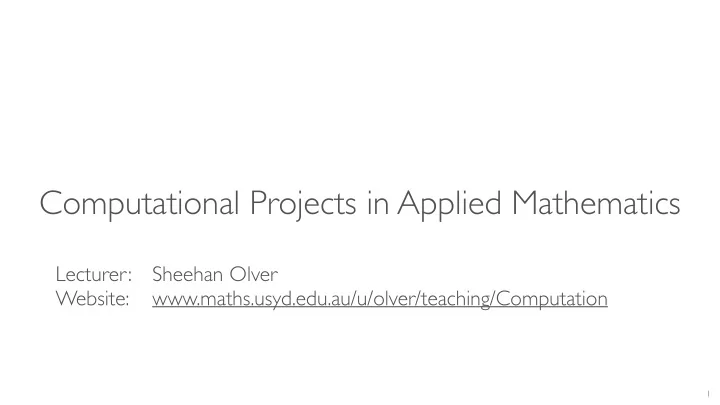

Computational Projects in Applied Mathematics Lecturer: Sheehan Olver Website: www.maths.usyd.edu.au/u/olver/teaching/Computation 1
COURSE TOPICS • Topic 1: The fast Fourier transform and function approximation • Topic 2: Spectral methods for differential equations • Topic 3: Numerical linear algebra • Advanced Topics in Fluid Dynamics next semester recommended for computational topics on time-evolution PDEs 2
Background knowledge not covered Please learn on your own (Wikipedia) • Computer arithmetic – Integers versus IEEE floating point numbers – Round-off error • Relative accuracy versus absolute accuracy • Programming language – E.g., Julia, Matlab, Mathematica or Python – Fortran or C if you are a masochist • Big-O, little-O and ~ notation 3
Final project • A final project will be due during exam weeks • This project is open ended – The idea is to come up with a computational problem on your own to study • A proposal will be due 16 April – For suggestions to ensure it is a good project – Every student’s project must be different, chosen on a first-come basis • Example projects will be posted on the website – You obviously can’t use the same idea for a project – Don’t copy projects from other students in previous years 4
Intro to function approximation 5
• The starting point of this course is that functions can be represented by (finite- dimensional) vectors • This corresponds to approximation in a basis • For example, suppose f ( x ) is a function (say on [ − 1 , 1] ) and ψ 0 ( x ) , ψ 1 ( x ) , . . . are fixed functions, and we can approximate (in some sense) n − 1 � f ( x ) ≈ f k ψ k ( x ) k =0 • Then we can represent the function f by the n -dimensional vector: � � f 0 . can be represented by . f � � . � � f n − 1 6
• A classic and fundamental example is Fourier series • We take the basis ψ 0 ( θ ) = 1 ψ 1 ( θ ) = ��� θ , ψ 2 ( θ ) = ��� θ , ψ 3 ( θ ) = ��� 2 θ , ψ 4 ( θ ) = ��� 2 θ , . . . • I.e., we want to approximate on [ − π , π ) (here n is even): f ( θ ) ≈ f 0 + f 1 ��� θ + f 2 ��� θ + · · · + f n − 1 ��� n /2 θ 7
Demo 8
• We have seen the effectiveness of this approach for computations • Now we want to understand the mathematics that makes this possible • We begin with a basic fundamental question: � Given a function f ( θ ) defined on [ − π , π ) , that we can evaluate pointwise � Calculate coefficients f 0 , . . . , f n − 1 so that ( n even) f ( θ ) ≈ f 0 + f 1 ��� θ + f 2 ��� θ + · · · + f n − 1 ��� n 2 θ • To do this, we will need to approximate integrals: quadrature 9
Recommend
More recommend